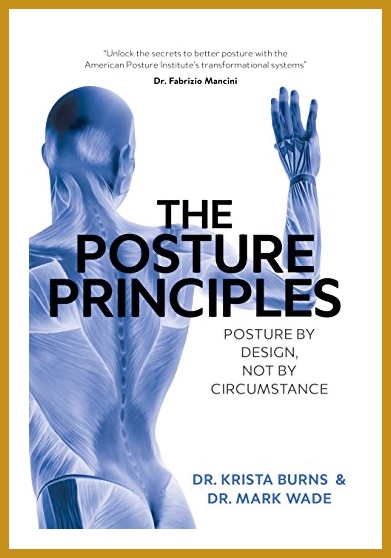STRENGTH SENSEI BOOKSHELF
The Posture Principles
If you can get past the confusing subtitle of this book, “Posture by Design, Not by Circumstance,” you’ll enjoy The Posture Principles. Although the target audience is the healthcare professional and spans 336 pages, it’s surprisingly readable and explains complex subjects that much of the general public could understand.
The authors, Dr. Mark Wade and Dr. Krista Burns, are Doctors of Chiropractic and Certified Postural Neurologists. Co-founders of the American Posture Institute, they have taught students in 40 countries. The Posture Principles is an excellent overview of their program.

Consider The Posture Principles a “one-stop shop” for all things posture. Besides covering how important posture is to qualify of life, it provides practical guidelines on assessing posture and prescribing special exercises to correct imbalances. Most importantly, the authors explain lifestyle habits to prevent postural issues from developing in the first place.
The book is divided into the following four sections. Although it’s tempting to skip the first two chapters that focus on theory, you should study them to understand better why the evaluation and treatment methods are designed in the manner they are.
- Theory and Principles of Postural Correction
- The Principle Anatomic Posture Quadrants and Their Physiologic Functions
- Structural, Functional, and Neurological Posture Evaluation
- Clinical Application for Posture Correction Strategies
Each section is supported with relevant illustrations and photos, and there is an extensive reference section for those who want to explore more on a specific topic. If there’s one criticism, those who do not have a medical background could benefit from more illustrations explaining some of the more complex ideas presented.

The authors present what could be considered a holistic approach to posture, showing how seemingly unrelated factors could influence posture. Yes, there is a discussion about sitting posture, how to design a computer workstation, and why staring down at a cell phone for long periods can be a pain in the neck. But the reader will also learn about such topics as choosing the appropriate footwear, walking, and the best ways to carry a backpack and even hold a purse! And whereas many books on postural correction will prescribe extensive exercise programs, the strengthening and stretching exercises in this book are few and simple.
What also sets The Posture Principles apart is that the authors consider the neurological influences on posture, particularly how correcting eye convergence is critical to achieving permanent postural balance.
In simple terms, the eyes provide the brain with information about the body’s orientation in space. An example of a convergence test would be to hold a pencil about a foot in front of you at eye level, stare at the tip, and slowly bring the pencil to your nose while focusing on it. If one eye pulls in before the other, this indicates there is a convergence imbalance. To correct it, Wade and Burns provide several simple exercises that a healthcare professional can easily teach.
The Posture Principles may not be the only book a healthcare practitioner should read about posture. Still, it’s a good starting point that provides an extensive overview of how the posture system works, how to correct postural imbalances, and adopt a lifestyle to avoid pain and improve performance. (TSS)
[You can purchase The Posture Principles by Dr. Krista Burns and Dr. Mark Wade in Kindle and paperback versions through Amazon.com.]
— lead photo by Miloš Šarčev
